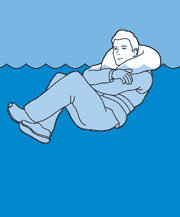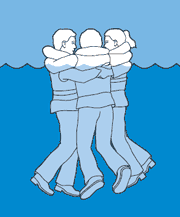Survival in Cold Water
Cold is one of the greatest threats to the lives of everyone on the water.
It is also the biggest enemy on Lake Taupo, with water temperatures in our Great Lake dropping to as low as 10°C in Winter.
In waters of 10°C, the average person will be semi-conscious or unconscious within 1 hour. Death from drowning will often occur within 2 hours, even with a lifejacket. In waters of 15°C, a person might survive for up to 6 hours.
The greatest threat from cold is hypothermia. In cold, the body first prioritises the vital organs – the heart, lungs and brain – to enable them to function normally. It reduces warm blood flow to the outer layers of the body and the extremities. Hands and feet feel cold, and shivering starts in an involuntary attempt to generate more heat.
As the body’s core temperature drops, the vital inner-organs also become affected. As the brain cools, consciousness is affected. Without correct treatment, death will follow.
Cold can also kill quickly. The shock of suddenly entering very cold water can cause a large gasp for air, and a massive increase in lung and heart effort. This alone can result in muscle spasm, drowning, or heart attack.
While the effects of immersion in cold water vary depending on factors such as body fat, strength, and attitude, certain techniques can improve your chance of surviving long enough to be rescued.
- Wear a lifejacket. A full lifejacket helps to keep the head and airway clear of the water, even when strength and mental capacity is waning. It will also make adopting heat-loss reducing postures much more stable.
- The more clothes you have on, the better. Do not get undressed to enter the water. If there is time, add more layers. A person wearing two layers of woollen clothing will lose less than a quarter of the heat a person wearing only a swimsuit will lose. Wear as many layers of wool as possible, covered with a waterproof layer. The wool will trap warmer layers of water closer to the body.
- Try not to panic. Panic can impair breathing and hasten the drowning process. Hyperventilation can occur when a person is unexpectedly immersed in the water. A mistimed breath can result in a laryngospasm, which sometimes results in loss of consciousness. A person who does not panic may simply have to cope with hyperventilation, which will eventually subside.
- Where possible, get out of the water. In water the body loses heat 20 to 30 times faster than it does in air. Even if you feel colder out of the water, try to clamber on top of an overturned boat or any floating wreckage.
- If you are forced to stay in the water, adopt the HELP (Heat Escape Lessening Posture). Hold the arms tight against the chest, press the thighs together, and raise up the knees to protect the groin. This posture will increase survival time by nearly 50%. It will be most easy to adopt when wearing a lifejacket.
- Groups of three or more should adopt the huddle position. The sides of the chests and the lower torsos are pressed together, arms hugging each other around the lifejackets. Intertwine legs as much as possible, and talk to one another. Children succumb to cold much more quickly than adults, and should be sandwiched in the middle of the group.
- Consider options before swimming to shore. If you decide to swim for shore, consider that tests show an average person wearing a lifejacket and light clothing could swim about 1.85 kilometres in water of 10°C.


The aim of the "HELP" (left image) and "Huddle" positions is to keep the warm water close to the body from being replaced by colder surrounding water.



